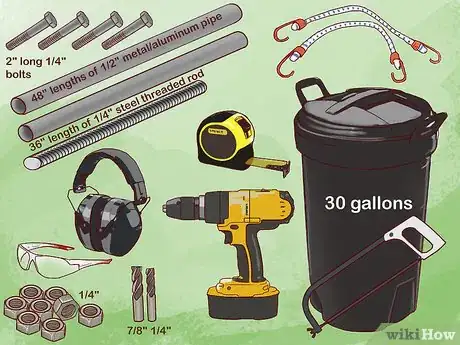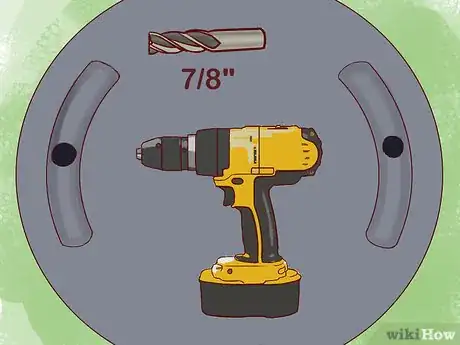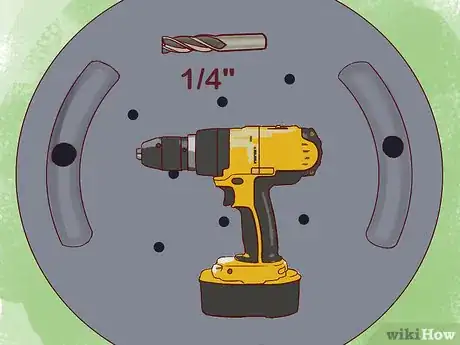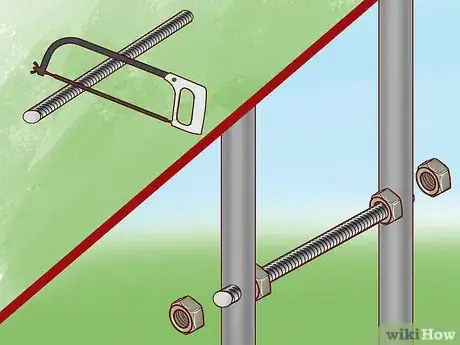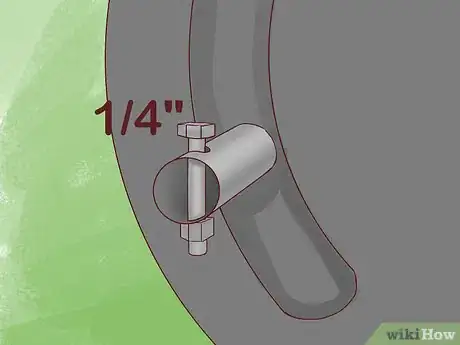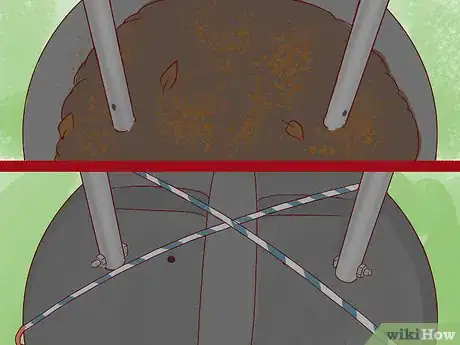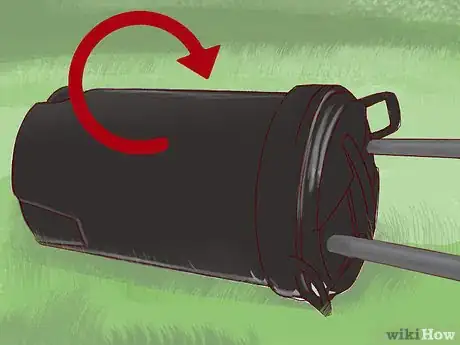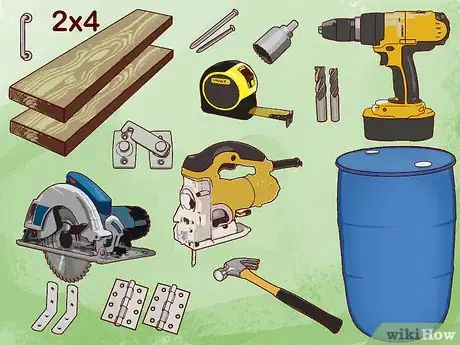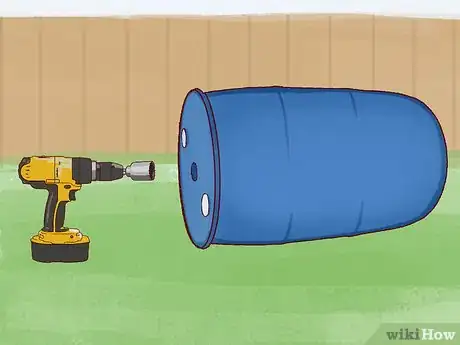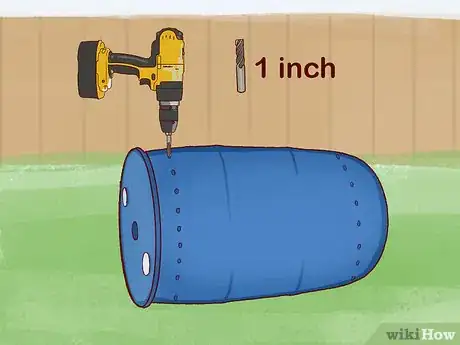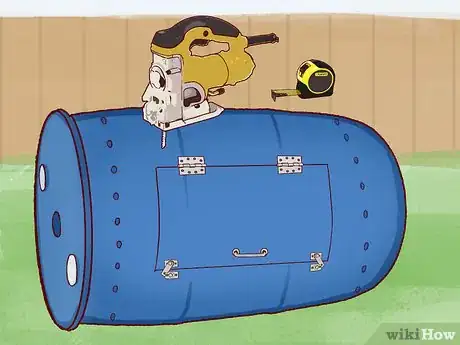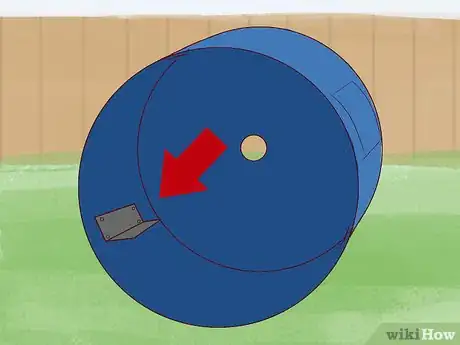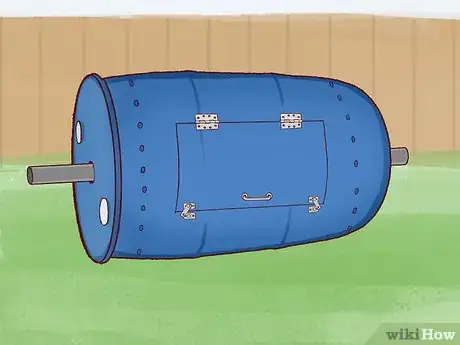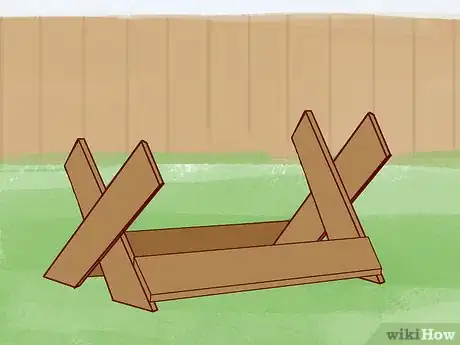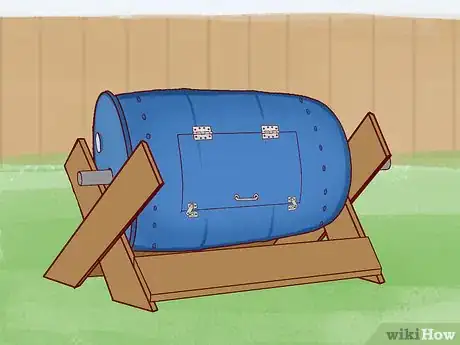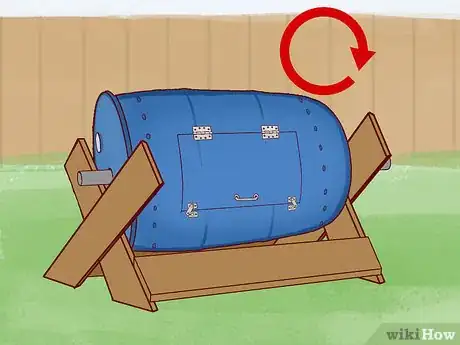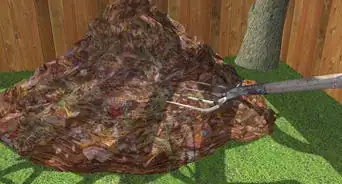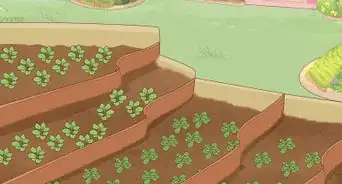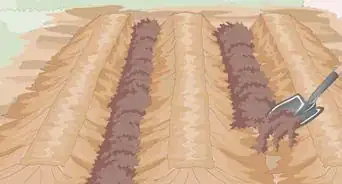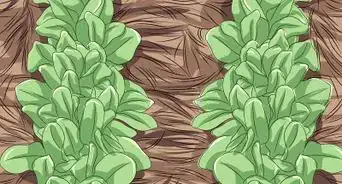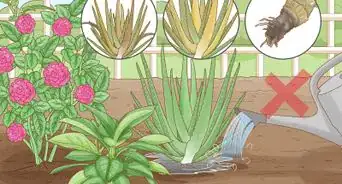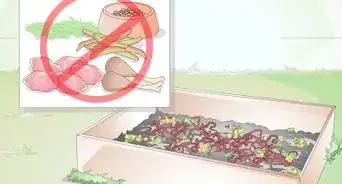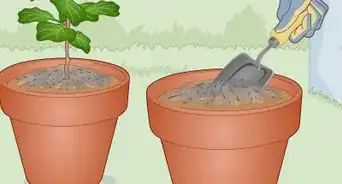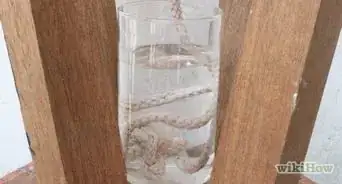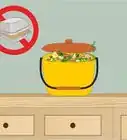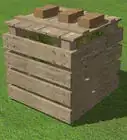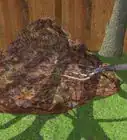wikiHow is a “wiki,” similar to Wikipedia, which means that many of our articles are co-written by multiple authors. To create this article, 37 people, some anonymous, worked to edit and improve it over time.
wikiHow marks an article as reader-approved once it receives enough positive feedback. This article received 19 testimonials and 93% of readers who voted found it helpful, earning it our reader-approved status.
This article has been viewed 1,052,935 times.
Learn more...
One of the keys to successful composting is aeration. Bacteria need oxygen to carry out the aerobic respiration that creates a rich compost. One way to aerate your compost is with a pitchfork or a compost turning tool. This can be an arduous task. Using a tumbling composter can make things easier. Since most tumbling composters can be fairly expensive, costing well over $100, consider building your own. For much less money and a few hours of your time, you can build your own tumbling composter by following the steps below.
Steps
Building an On-the-Ground Tumbling Composter
-
1Gather the materials needed to build an “on-the-ground” tumbling composter.[1] An inexpensive and less complicated way to build your own tumbling composter is by creating an “on the ground” tumbling composter, which is simply a container outfitted to hold compost that you “turn” by simply rolling the container across the ground. Purchase or obtain a large cylindrical container with a lid that fits tight. A garbage can works best, and is likely the easiest to find. Select either a plastic or metal garbage can that will hold at least 30 gallons; large containers used for composting hold 55 gallons. Wash the garbage can or container thoroughly if it has been used. Additional materials you’ll need include[2] :
- Two 48" lengths of 1/2" metal/aluminum pipe
- One 36" length of 1/4" steel threaded rod (zinc plated)
- Four 2" long 1/4" bolts
- Eight 1/4" nuts
- A 1/4" metal drill bit
- A 7/8" drill bit
- Drill
- Hacksaw
- Measuring tape
- Ear and eye protection
- 2 elastic bungee cords that are the same length as the can's diameter (optional)
-
2Drill two holes into the lid and bottom of your container using a 7/8” drill bit. The holes you’ll drill into the lid need to be 4” from the outer edge of the lid and directly across from each other, or specifically 180 degrees apart. The holes at the bottom of the container need to be 2” from the edge. You’ll need to place the holes at the bottom in a sunken part of the container’s base because you’ll be sticking metal or aluminum pipes through these holes and you want your tumbling composter to be able to stand upright once assembled.Advertisement
-
3Create aeration holes all over your container. Drill several holes, about 15-20, into the top and bottom and along the sides of the container using your drill and a 1/4” drill bit. Space the holes evenly. The holes will allow oxygen to flow freely throughout your tumbling composter.
-
4Drill two holes straight through each end of your two metal or aluminum pipes using a 1/4" metal drill bit. Make sure to place them as close to the end of pipes as possible. Doing so will enable your tumbling composter to stand up properly.
-
5Drill two additional holes into each pipe, and then thread your rod through those holes. Once the pipes and connected rod are placed inside the container, the rod will need to rest in the middle of the container. Therefore, your two additional holes must measure at half the height of your container. Measure the height of your container and divide that measurement by two. The number you come up with will be the length you measure on your two pipes to determine where your two holes will be drilled. Use your 1/4" metal drill to drill the two holes straight through the pipe.
- Before you thread your rod through the new holes, it’ll need to be cut down to size in order to fit inside your container. To do this, measure the diameter of the container at the point where the pipes’ holes will be. You found this point earlier by dividing the height of your container by two. When you come up with the diameter of the container, cut the rod 1” shorter than that, so it’ll fit easily inside the container.
- Slide one end of the rod through one of the pipes until the pipe is about 3” from the other end of the rod. Then screw onto the rod two of the 1/4" nuts. Start at the end of the rod that is farthest from the pole. Each nut should be about 4" from each end of the rod. Once secured, the first nut will be right next to the pole, while the second nut will be about 4" from the end of the rod. Once the second nut is secured, slide the rod through the second pipe, stopping when the pipe touches the 1/4" nut. Secure the two pipes by screwing an additional 1/4" nut on the outer edges of the rod next to each pipe.
-
6Secure the pipe and rod structure to your container. Place the structure inside the container and then turn the container on its side to make it easier to thread the ends of the pipe through the two 7/8” holes in the bottom of the container. Secure the pipes by sliding a 2” bolt through the 1/4" holes you drilled into the ends of the pipes, and then screwing two 1/4" nuts onto the ends of each bolt. Stand the container upright and then secure the lid by threading the tops of the pipes through the two 7/8” holes.
- You’ll need to drill holes into the length of the pipes just above the lid, so that once bolted the lid will stay secure when you roll it on the ground.
- Use a marker to mark the spots where you’ll drill your holes, and then to ensure your holes are even, disassemble your tumbling composter, and lie the pipes flat on the ground when you drill them.
- Drill two holes straight through each pipe using the metal 1/4" drill bit, and then reassemble your tumbling composter.
-
7Fill your tumbling composter with composting ingredients and secure the lid. To secure the lid, follow the same method used to secure the pipes to the bottom of the container. Use two bolts and nuts on each side of the bolts, after you’ve filled your tumbling composter with composting ingredients. Slide one bolt through each of the 1/4" holes you've just drilled, and then secure those bolts by attaching a 1/4" nut to each end of the bolts. If necessary, you can secure bungee cords over the top of the container by laying them in a crisscross pattern over the lid and securing the cords either underneath the handles of the lid or through a few newly drilled holes.
-
8Test the security of your lid by rolling your new tumbling composter across the ground. Make sure your lid is tightly secured by rolling it across the ground. If dirt begins to spill from around the top, adjust your bolts, or tighten or obtain bungee cords to further tie down your lid.
Building a Barrel-Roll Tumbling Composter
-
1Gather the materials needed to construct a “barrel-roll” tumbling composter.[3] If you prefer to expend less energy turning your compost, building a “barrel-roll” tumbling composter will help. This type of tumbling composter sits atop a wooden structure and turns on an axle, such as a PVC or steel pipe, that runs directly through it. You’ll need to purchase or obtain a plastic or steel barrel, between 20 and 55 gallons (75-200 liters), including a 48 inch (1.25 meter) length of 2 inch (5 cm) schedule 80 PVC pipe, or a length of 1 1/2 to 2 inch (3.8-5 cm) galvanized steel pipe. You’ll also need:
- 2X4 treated lumber
- Nails
- Circular saw
- Jigsaw
- Drill motor, drill paddle bit, and drill bits
- Hole saw
- Basic hand tools (hammer, measuring tape, flexible metal ruler, framing square)
- Hinges
- Latches
- Door handle
- “L” brackets
-
2Drill holes in the center of the top and bottom of your barrel. Measure the diameter of each end of your barrel, and then divide that measurement by two to determine the center point. Your holes should be large enough to fit the pipe you’ll be using as the axle. If you can, cut off a small piece of your axle pipe, place it over each center mark, and trace a circle along the outside of the pipe. If you can’t, measure the diameter of your axle pipe and draw a circle of the same size around each center point. Once your circles have been created, use a drill paddle bit or hole saw of an equal size to create your holes.
-
3Drill holes into the body of the barrel for aeration. Using a 1-inch (2.5 cm) bit space 15-20 holes evenly along the sides of the barrel. This will allow oxygen to flow freely throughout the container.
-
4Create a door on the side of your barrel. Before you start cutting out a door, trace the shape of the door you want along one side of the barrel using a flexible metal ruler and a framing square. The measurements for the door will differ depending on the size of your barrel. If your barrel is on the smaller size, like 20 to 30 gallons, trace a 12” by 12” square. If it’s a 55 gallon barrel, you can outline an 18” by 12” rectangle. The longer side should be parallel to the length of the barrel.
- Make a couple small holes in one of the corners using your drill to allow space for your jigsaw blade to start cutting. Continue to use the blade all the way around the outline of the door until the shape is removed.
- The door will likely be a bit flimsy once secured. If your barrel is plastic, secure two pieces of wood to the inside of the barrel, one along the side where you’ve placed your hatches and the other on the opposite end where you’ll place your latches and handle. If your barrel is metal, use two steel plates instead of wood. Consider flattening two “L” brackets to use for your steel plates.[4]
- To secure the door, install two hinges at the top corners, then install two latches at the bottom corners to lock the door. You can place a handle at the center point of the two latches to help with opening and closing the door.
-
5Attach a sheet of metal inside the barrel to act as a mixing fin to help turn the compost when the barrel rotates. A long spare piece of galvanized sheet metal bent into an “L” shape and bolted to the interior wall of the barrel will do this nicely. Put the fin opposite from the hatch, so as to weight balance the empty container.
-
6Pass the pipe or post through the center holes. When you’re ready, slide the pipe through the center holes. The length of pipe sticking out of each side of the barrel should be long enough to rest each end on the wooden structure you’ll create.
- If you’re using a plastic barrel, the weight of the compost inside your tumbling composter can break the plastic[5] , so before inserting the pipe through the holes secure two slabs of wood to the barrel to distribute the weight of the compost.
- Take two slabs of wood, such as 2”x4” pieces, and drill into each piece a hole large enough to fit your pipe through. Line each hole up to the holes on either end of your barrel and nail the boards to the barrel.
- Alternately, you can secure an “L” bracket to each side of the pipe, which will also distribute the weight of the compost.
-
7Build a wooden saw buck to support the compost barrel. Nail 2 sets of 2x4s (pieces of wood that are 1.5″ × 3.5″ or 38×89 mm in terms of height and width, respectively) in an x-frame, and nail two 2x4s across the feet at the bottom for support.
-
8Set the barrel with the pipe in the wooden 2x4 saw buck.
-
9Rotate the barrel in the sawhorse frame using the pipe or post as an axle to ensure it works properly. If it does, you can now fill your tumbling composter with leaves and other compostable material, and allow your new "garden helper" to do its job.
Can You Mix Compost With Soil?
Community Q&A
-
QuestionWhere can I get a barrel?
 Community AnswerWe got a 55-gallon plastic barrel from a DIY car wash for $12. It had regular car wash soap in it -- NOT engine degreaser, which can leave toxic residues.
Community AnswerWe got a 55-gallon plastic barrel from a DIY car wash for $12. It had regular car wash soap in it -- NOT engine degreaser, which can leave toxic residues. -
QuestionCan I use worms in this tumbler composter?
 DonaganTop AnswererWorms are better suited to stationary bins. The tumbling action can harm worms.
DonaganTop AnswererWorms are better suited to stationary bins. The tumbling action can harm worms. -
QuestionCan I add wheels to it for portability?
 Community AnswerYes. Choose metal casters and secure them firmly, so the composter will remain stable.
Community AnswerYes. Choose metal casters and secure them firmly, so the composter will remain stable.
Warnings
- Work carefully when operating machinery and sharp tools.⧼thumbs_response⧽
- Wear ear and eye protection when needed.⧼thumbs_response⧽
Things You’ll Need
On-the-Ground Tumbling Composter
- One 30-55 gallon metal or plastic cylindrical container with a tight-fitting lid, such a garbage can
- Two 48" lengths of 1/2" metal/aluminum pipe
- One 36" length of 1/4" steel threaded rod (zinc plated)
- Four 2" long 1/4" bolts
- Eight 1/4" nuts
- A 1/4" metal drill bit
- A 7/8" drill bit
- Drill
- Hacksaw
- Measuring tape
- Ear and eye protection
- 2 elastic bungee cords that are the same length as the can's diameter (optional)
Barrel-Roll Tumbling Composter
- One 20-55 gallon metal or plastic barrel
- One 48” (1.25 meter) length of 2” (5 cm) schedule 80 PVC pipe, or a length of 1 1/2" to 2” (3.8-5 cm) galvanized steel pipe
- 2X4 treated lumber
- Nails
- Circular saw
- Jigsaw
- Drill motor, drill paddle bit, and drill bits
- Hole saw
- Basic hand tools (hammer, measuring tape, flexible metal ruler, framing square)
- Hinges
- Latches
- Door handle
- “L” brackets
References
- ↑ https://www.youtube.com/watch?v=eNHDJnYz4jY
- ↑ http://www.compostjunkie.com/compost-tumbler-plans.html
- ↑ https://survivalsherpa.wordpress.com/2013/01/31/building-a-dirt-road-girl-compost-tumbler/
- ↑ https://thrivefarm.wordpress.com/2012/03/20/diy-compost-tumbler/
- ↑ https://kindacrunchykate.wordpress.com/2011/03/09/how-to-make-a-compost-tumbler-very-inexpensively-a-photo-tutorial/
- ↑ https://kindacrunchykate.wordpress.com/2011/03/09/how-to-make-a-compost-tumbler-very-inexpensively-a-photo-tutorial/
About This Article
If you want to build an on-the-ground tumbling composter, drill holes in the bottom and lid of a large trash can, then drill holes in the bottom, middle, and top of 2 long pipes. Thread a rod through the middle 2 holes in the pipe and secure the rod with nuts and bolts, then pass the bottom of the pipes through the bottom of the trash can and bolt that into place as well. Place the lid on the trash can over the pipes and bolt it into place, and use bungee cords to secure the lid further if you need to. Keep reading to learn how to build a barrel-roll tumbling composter!
